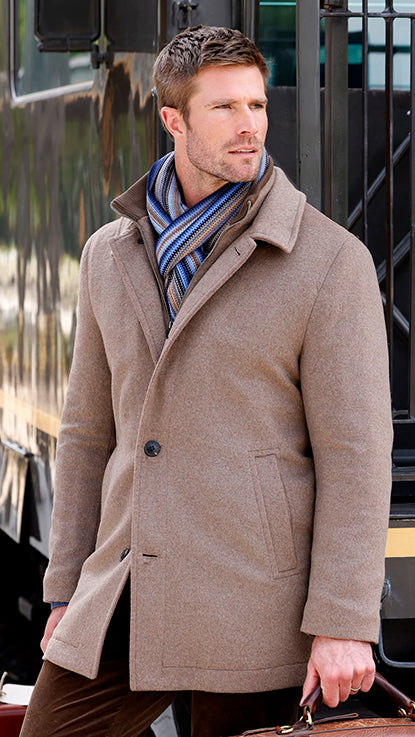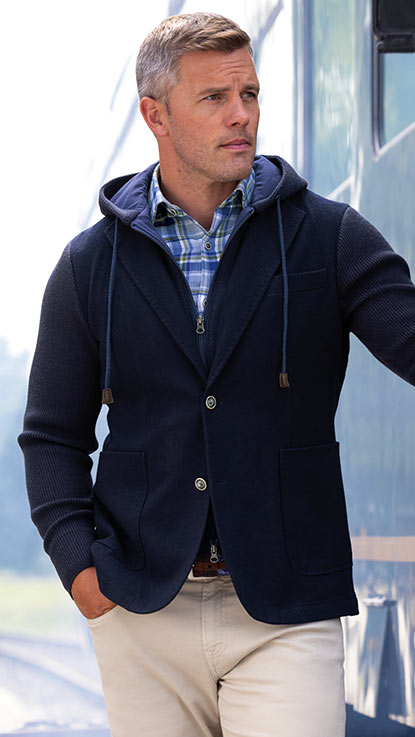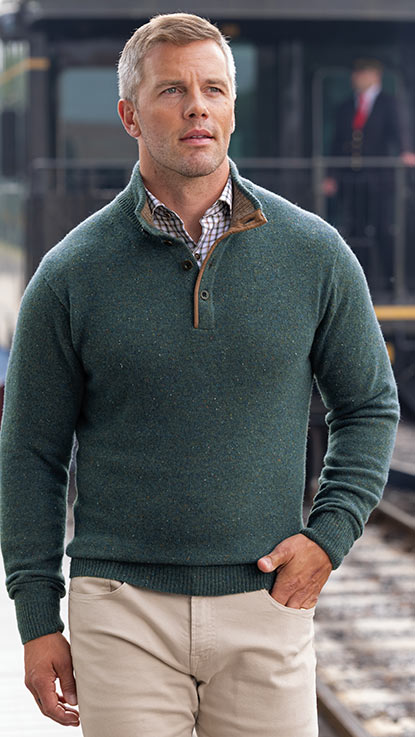Explaining the Definition of Business Casual for Men
By Stephan Belov

For better or worse, dress codes in many modern workplaces have become much less formal than in decades past. Office dress codes used to be so simple back in the day: if you worked in a white-collar professional setting, you wore a suit and tie. Until around the mid-1960’s, wearing a hat with a suit was also de rigueur for men. And although a suit may not have been the most comfortable or practical apparel, a standardized and unambiguous dress code made it simpler to know what was appropriate to wear to work.
Nowadays, with the exception of law offices, investment firms, banking and financial institutions, as well as some senior level management positions - suits are no longer the standard attire of the modern workplace. In the last few decades, most of corporate America has instead adopted “business casual” as the dress code of choice.
So what is business casual for men?
The truth is, while there are general rules and guidelines - there is no universal, standard definition of what constitutes business casual. There is definitely some consensus as to what business casual is not. Most agree that strictly casual items such as jeans, shorts, t-shirts, sweatshirts, sneakers, and sandals are not appropriate. However, some workplaces have a more relaxed interpretation and don’t take issue with jeans – as long as they are not too baggy and come in a dressier dark indigo wash.
Within a broad dress code category like business casual, you always have the option of going a touch dressier, or a touch more casual. For example, a short sleeve polo with chinos and loafers is appropriate for business casual, but skews pretty casual. On the other hand, wearing dress slacks with a tucked-in dress shirt, leather oxfords, a blazer, but no tie is still business casual - but makes for a much dressier outfit. There may be times at the office when going a bit more casual makes sense. It’s usually very comfortable, and can make you seem more approachable and relatable. But if you have a big meeting that requires some formality, or if you are in a senior-level position and are expected to set an example - you may opt to dress up your look. And if you’re just starting at a new job, it’s always a good idea to go a bit dressier at first, until you learn the level of formality that is expected of you.
So what items of clothing are actually appropriate for business casual? We’ll give you the relevant details broken down by category.
Pants and Bottoms
In general, a clean-pressed pair of chinos, corduroys, or dress slacks are acceptable options for bottoms. One style that is gaining some popularity in menswear lately is the five-pocket pant. These pants are cut in a standard “jean-style” with five open pockets and rivets, but the fabric is not made of denim. Instead, it can be just about anything from a cotton twill as seen on chinos or khakis, to something uncommon like a micro-corduroy or a moleskin weave. Some versions of the five-pocket pant can be dressy enough for business casual but as a whole, these pants tend to skew casual. If your office does casual Fridays or has a more relaxed dress code, you can wear five-pocket pants without a problem. If you’re unsure, chinos or corduroys are slightly dressier and make for a safer bet. And of course, dress slacks will be your dressiest option in this category. Just make sure that whatever you choose is neatly ironed and free of any wrinkles.
Shirts and Tops
A good rule of thumb for choosing an appropriate business casual shirt is to go for one with a collar. Tucked in dress shirts are your safest and most conservative choice. Again, everything you wear should be pressed of all wrinkles and neat. So if you don’t like ironing, a wrinkle-free shirt makes for a perfect everyday option.
You can also go a bit more casual and wear a long sleeve sport shirt (commonly called a “button-down” or "button-up"), but you should still have it tucked in. On a sport shirt, a spread collar is dressier than a button-down collar, but either one is acceptable for business casual.
A short sleeve polo is the most casual option, but most offices will still allow it. With polos, I find a smooth jersey interlock fabric to be a lot dressier and more work-appropriate than a standard tennis-style pique mesh knit. If you’d like to wear a polo to the office but don’t want it to be too casual, one with a smoother finish and a slight luster to the fabric will always look dressier. And unless it’s casual Friday, it’s always a good idea to tuck your polo in at the office.
During the colder months you can layer on a sweater, but avoid casual sweatshirts or hoodies. A merino wool V-neck or crewneck sweater is always a great choice. Cardigans, sweater vests, button-mocks, and some dressier half zips are also appropriate. Sweaters with bold patterns such as a Fair-Isle or abstract knit usually lean very casual, and may only be appropriate on casual Fridays.
Lastly, if you’d like to elevate your outfit a bit but still stay within the bounds of business casual, you can add a blazer or sport coat with a conservative pattern to your ensemble. However, don’t wear a suit jacket as a blazer without the matching suit pant. This is a style faux pas because a suit jacket and its matching pant are always meant to be worn together – hence the name “suit.” The buttons on a blazer or sport coat will usually be made of materials such as metal or horn, and tend to have a bit more contrast with the jacket fabric. A suit jacket’s buttons blend in more with the fabric, which give it a dressier look.
Shoes and Accessories
As far as shoes go - brogues, oxfords, derbies, monk straps, or loafers are great choices. In these styles, you can never go wrong with an all-leather design, but suede or nubuck can be nice alternatives as well. Some styles like the monk strap or a wingtip brogue are much more fashion-forward compared to a something like an oxford or a derby. What you choose should mostly be up to personal preference, but it always helps to remember the type of office or industry you’re in before making a sartorial judgement call. You might get away with a navy suede monk strap if you work in the fashion industry or a West Coast tech firm, but they may look too fashion-forward if you’re in a conservative banking or consulting environment.
Always wear these shoes with proper dress socks, and never with white athletic socks. The socks themselves can have a little bit of pattern and color to them – it’s a great way to subtly show some personality. They can be made of cotton or wool, but should be thinner than an athletic sock and be of a regular crew length, which ends just below your calf.
For belts, a good rule to follow is to have the color of your belt match the color of your shoes. The color itself doesn’t have to be a 100% accurate match, and you can even get away with mixing the materials between the belt and shoe, i.e. wearing a full-grain leather belt with a suede shoe. However, it’s not a good idea to wear a belt and a pair of shoes in completely different colors. If you wear your shirt tucked-in, it’ll be very noticeable in a bad way. Also, belts that are thinner in width are considered to be dressier, and wider belts are more casual. As mentioned before, business casual allows for a bit of leeway between formal and casual, but just as with color, it’s always a good idea to match the dressiness of your belt to that of your shoes. Even in the same color, you wouldn’t wear a thick, rugged, large-buckled leather belt with elegant Italian bit loafers.
Other accessories for men should generally be kept at a minimum in a business casual environment. Obviously, wedding rings are completely fine. A nice watch is always a classy choice, but avoid digital sport watches, watches with rubberized straps, or anything that’s too big, bright, or flashy. When it comes to men’s timepieces, subtlety will always go a long way in the workplace. Piercings on men and visible tattoos are almost never appropriate in a business casual environment.
As a whole, ties are completely optional in business casual, and chances are you won’t see too many people wearing them in an office with this kind of dress code. However, there are times when you can throw a tie on with a dress shirt and a sportcoat or blazer. It’ll elevate your look even further than if you were to wear it all without a tie, and this could be really useful when you want to look sharp without resorting to a suit. If you aren’t planning on wearing a blazer or sportcoat, however, I’d recommend against wearing a tie with only a dress shirt and slacks. Some men think that this will dress them up just enough without looking like they’re overdressed or trying too hard. In reality, this just makes your outfit look incomplete. A tie will always look better when accompanied by a jacket, so if you’re going to wear a tie – dress up all the way.
You’ll rarely, if ever, have need for cufflinks if you go business casual. In general, French cuffs should be worn with a suit and tie on more formal occasions. However, some guys can wear them well with a blazer or a sportcoat – which could be business casual. It would definitely dress the look up even further, but would need to be balanced in a way where the dressiness of the shirt and cufflinks doesn’t clash with the relative informality of the blazer or sportcoat. It’s possible to pull off, but you absolutely must know what you’re doing or it’ll look strange, so proceed with caution.
Final Notes
Although business casual dress standards can be vague, you actually get quite a lot of freedom in regards to how formal or informal you can go within this category. Dressing successfully for the job essentially comes down to knowing the rules of your office, how your coworkers and bosses expect you to dress, and a bit of good judgment. It’s usually better to be just a bit dressier than the norm, and to take the time to figure out how conservative or fashion-forward your office is as a whole. Ultimately, people’s attention at the workplace should be on you, rather than on your clothes. The things you wear should add to, rather than distract from, your professional image.






